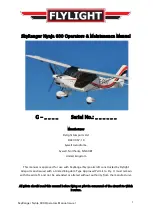
EN
13
12
During a forward launch we advise to NOT use the power launch technique. During the
inflation the power should be progressively applied once the wing is half way up. Applying the
power too early may inhibit the inflation characteristics of the center part of the wing, causing
the wing tips to come up faster.
Reverse Launch -Light to Strong Winds
Lay out your Speedster 2 as you would for the forward launch. However, this time face the
wing, and attach the risers in the correct manor (half a turn in each riser, and crossed in the
direction you want to turn). Now you can pull up the Speedster 2 by its A-risers. Once the
wing is overhead, brake it gently, turn and launch.
In stronger winds, be prepared to take a few steps towards the glider as it inflates. This will
take some of the energy out of the glider and it will be less likely to over-fly you. Once stable
and above your head apply progressive power and accelerate smoothly for a controlled take
off.
Practice ground handling and launching as much as possible! It is great fun, and will give you
a much better feel for your Speedster 2s flight characteristics. It will also improve your overall
enjoyment of flying by making your launches easier and safer.
The Climb Out
Once in the air you should continue flying into wind whilst gaining height. By setting the
trimmers to the first white line position you will achieve the best climb rate. Do not attempt
to climb too steeply or too quickly by using the brakes or slow trim. The wing already has a
high angle of attitude, coupled with a higher AoA (if you use the brakes) plus the engine’s
full thrust acting on the pilot, this could contribute to make the glider more prone to stall.
Furthermore, in the event of an engine failure the resulting backward pendulum motion of
the pilot and the forward dive of the wing may bring you back to the ground very hard. Do
not initiate turns until you have sufficient height and airspeed. Avoid low turns downwind with
insufficient airspeed.
The Speedster 2 is well damped in roll but under certain circumstances it is possible for the
pilot to induce oscillations. This is caused by a combination of the engine/propeller torque
and pilot weight shift and/or brake inputs. To stop oscillations it is best to reduce the power
slightly and ensure that you remain static with weight shift and brake inputs. Once settled
you can once again apply full power. Under full power the torque effect will attempt to gently
turn the wing, using weight shift or adjusting the trims asymmetrically is the best method to
correct this.
The handling characteristic of the Speedster 2 is truly amazing. We have worked hard on
tuning the wing so that it turns tightly but also efficiently, as the ability to climb in a turn is
very important for powered and free flight, making the climb out fun and thermalling easy.
Normal Flight
Once at a safe height you can release the trimmers for a faster cruise speed. If your motor has
enough power, the Speedster 2 will achieve very good straight line speeds whilst maintaining
level flight with trims fully released and full speed bar applied. Be cautious when releasing the
trimmers beyond the upper red line, only do so in calm conditions.
For better penetration in headwinds and improved glide performance in sinking air, crosswinds
or headwinds, you should fly faster than trim speed by using the accelerator system, or the
trimmers. In turbulent air the reflex profile is very stable. It will resist reasonable levels of
turbulence with a high resistance to collapse without active pilot input. The faster the wing is
flown the more inherent stability there is, as the reflex has a greater effect. In mild turbulence
it may be best to not attempt to fly the wing actively and let the profile absorb the turbulence
itself, indeed application of the brakes whilst accelerated will reduce the inherent stability of
the profile. However in very strong turbulence Ozone recommends to return the trimmers to
the fully slow position and fly the glider actively. This way, you will be in the best position to
react correctly should a collapse occur.
For maximum efficiency whilst flying downwind, release the speed bar and return the trimmers
to the slow position.
IMPORTANT
Never apply the brakes
whilst using the speed
system - it makes the
wing more prone to
collapse.
IMPORTANT
Never take off with
a glider that is not
fully inflated or if you
are not in control of
the pitch/roll of your
wing.
Содержание Speedster 2
Страница 1: ...Pilots Manual...
Страница 2: ......
Страница 20: ...1258 Route de Grasse Le Bar sur Loup 06620 France...






































